Fe3O4@SiO2@VAN Nanoadsorbent Followed by GC-MS for the Determination of Polycyclic Aromatic Hydrocarbons at Ultra-Trace Levels in Environmental Water Samples
Abstract
:1. Introduction
2. Materials and Methods
2.1. Chemicals and Materials
2.2. Instrumentation
2.3. Synthesis of Fe3O4@SiO2@VAN Nanoparticles
2.3.1. Preparation of the Fe3O4 Nanoparticles
2.3.2. Preparation of Core–Shell Fe3O4@SiO2 Nanoparticles
2.3.3. Synthesis of Fe3O4@SiO2@VAN Nanoparticles
2.4. Extraction Procedure
2.5. Instrument Conditions
3. Results and Discussion
3.1. Characterization of Materials
3.2. Optimization of Extraction Conditions
3.2.1. Extraction and Desorption Time Optimization
3.2.2. Desorption Solvent, pH, and Salt Addition Optimization
3.3. Selectivity Evaluation
3.4. Establishment of Analytical Methods
3.5. Detection of Actual Samples
3.6. Comparison with Other Reported Methods
4. Conclusions
Supplementary Materials
Author Contributions
Funding
Institutional Review Board Statement
Informed Consent Statement
Data Availability Statement
Conflicts of Interest
References
- Sajid, M.; Nazal, M.K.; Ihsanullah, I. Novel materials for dispersive (micro) solid-phase extraction of polycyclic aromatic hydrocarbons in environmental water samples: A review. Anal. Chim. Acta 2021, 1141, 246–262. [Google Scholar] [CrossRef] [PubMed]
- Yi, P.; Zuo, X.-Z.; Liang, N.; Wu, M.; Chen, Q.; Zhang, L.-J.; Pan, B. Molecular clusters played an important role in the adsorption of polycyclic aromatic hydrocarbons (PAHs) on carbonaceous materials. Chemosphere 2022, 302, 134772. [Google Scholar] [CrossRef]
- Louvado, A.; Gomes, N.C.M.; Simoes, M.M.Q.; Almeida, A.; Cleary, D.F.R.; Cunha, A. Polycyclic aromatic hydrocarbons in deep sea sediments: Microbe–pollutant interactions in a remote environment. Sci. Total Environ. 2015, 526, 312–328. [Google Scholar] [PubMed]
- Lončarski, M.; Gvoić, V.; Prica, M.; Cveticanin, L.; Agbaba, J.; Tubić, A. Sorption behavior of polycyclic aromatic hydrocarbons on biodegradable polylactic acid and various nondegradable microplastics: Model fitting and mechanism analysis. Sci. Total Environ. 2021, 785, 147289. [Google Scholar] [CrossRef]
- Abdel-Shafy, H.I.; Mansour, M.S.M. A review on polycyclic aromatic hydrocarbons: Source, environmental impact, effect on human health and remediation. Egypt. J. Pet. 2016, 25, 107–123. [Google Scholar] [CrossRef]
- Ma, J.-P.; Xiao, R.-H.; Li, J.-H.; Yu, J.-B.; Zhang, Y.-Q.; Chen, L.-X. Determination of 16 polycyclic aromatic hydrocarbons in environmental water samples by solid-phase extraction using multi-walled carbon nanotubes as adsorbent coupled with gas chromatography–mass spectrometry. J. Chromatogr. A 2010, 1217, 5462–5469. [Google Scholar] [CrossRef]
- Tian, L.; Yin, S.; Ma, Y.-G.; Kang, H.-Z.; Zhang, X.-Y.; Tan, H.-X.; Meng, H.-Y.; Liu, C.-J. Impact factor assessment of the uptake and accumulation of polycyclic aromatic hydrocarbons by plant leaves: Morphological characteristics have the greatest impact. Sci. Total Environ. 2019, 652, 1149–1155. [Google Scholar] [CrossRef]
- Zhang, G.-C.; Wang, J.; Zhao, H.; Liu, J.; Ling, W.-T. PAH degradation and gene abundance in soils and vegetables inoculated with PAH-degrading endophytic bacteria. Appl. Soil Ecol. 2021, 168, 104193. [Google Scholar] [CrossRef]
- Avino, P.; Notardonata, I.; Perugini, L.; Russo, M.V. New protocol based on high-volume sampling followed by DLLME-GC-IT/MS for determining PAHs at ultra-trace levels in surface water samples. Microchem. J. 2017, 133, 251–257. [Google Scholar] [CrossRef]
- Thiäner, J.B.; Nett, L.; Zhou, S.-B.; Preibisch, Y.; Hollert, H.; Achten, C. Identification of 7–9 ring polycyclic aromatic hydrocarbons in coals and petrol coke using High performance liquid chromatography—Diode array detection coupled to Atmospheric pressure laser ionization—Mass spectrometry (HPLC-DAD-APLI-MS). Environ. Pollut. 2019, 252, 723–732. [Google Scholar] [CrossRef]
- Abboud, A.S.; Sanagi, M.M.; Ibrahim, W.A.W.; Keyon, A.S.A.; Aboul-Enein, H.Y. Calcium Alginate-Caged Multiwalled Carbon Nanotubes Dispersive Microsolid Phase Extraction Combined with Gas Chromatography-Flame Ionization Detection for the Determination of Polycyclic Aromatic Hydrocarbons in Water Samples. J. Chromatogr. Sci. 2018, 56, 177–186. [Google Scholar] [CrossRef] [PubMed]
- Nazir, N.A.M.; Raoov, M.; Mohamad, S. Spent tea leaves as an adsorbent for micro-solid-phase extraction of polycyclic aromatic hydrocarbons (PAHs) from water and food samples prior to GC-FID analysis. Microchem. J. 2020, 159, 105581. [Google Scholar] [CrossRef]
- Marsin, F.M.; Ibrahim, W.A.W.; Rashidi Nodeh, H.; Sanagi, M.M. New magnetic oil palm fiber activated carbon-reinforced polypyrrole solid phase extraction combined with gas chromatography-electron capture detection for determination of organochlorine pesticides in water samples. J. Chromatogr. A 2020, 1612, 460638. [Google Scholar] [CrossRef] [PubMed]
- Sun, Y.-Q.; Wu, S.-M. Analysis of PAHs in oily systems using modified QuEChERS with EMR-Lipid clean-up followed by GC-QqQ-MS. Food Control 2020, 109, 106950. [Google Scholar] [CrossRef]
- Cárdenas-Soracá, D.M.; Tucca, F.; Mardones-Peña, C.A.; Barra-Ríos, R.O. Development of an analytical methodology for the determination of organochlorine pesticides by ethylene-vinyl acetate passive samplers in marine surface waters based on ultrasound-assisted solvent extraction followed with headspace solid-phase microextraction and gas chromatography-tandem mass spectrometry. J. Chromatogr. A 2019, 1605, 360341. [Google Scholar]
- Perestrelo, R.; Silva, P.; Porto-Figueira, P.; Perira, J.A.M.; Silva, C.; Medina, S.; Câmara, J.S. QuEChERS-fundamentals, relevant improvements, applications and future trends. Anal. Chim. Acta 2019, 1070, 1–28. [Google Scholar]
- Tan, J.; Lu, X.-B.; Fu, L.; Yang, G.-S.; Chen, J.-P. Quantification of CL-PAHs and their parent compounds in fish by improved ASE method and stable isotope dilution GC-MS. Ecotoxicol. Environ. Saf. 2019, 186, 109775. [Google Scholar] [CrossRef]
- Benedetti, B.; Di Carro, M.; Magi, E. Multivariate optimization of an extraction procedure based on magnetic molecular imprinted polymer for the determination of polycyclic aromatic hydrocarbons in sea water. Microchem. J. 2019, 145, 1199–1206. [Google Scholar] [CrossRef]
- Siemers, A.-K.; Mänz, J.S.; Palm, W.-U.; Ruck, W.K.L. Development and application of a simultaneous SPE-method for polycyclic aromatic hydrocarbons (PAHs), alkylated PAHs, heterocyclic PAHs (NSO-HET) and phenols in aqueous samples from German Rivers and the North Sea. Chemosphere 2015, 122, 105–114. [Google Scholar] [CrossRef]
- Manousi, N.; Deliyanni, E.A.; Rosenberg, E.; Zachariadis, G.A. Ultrasound-assisted magnetic solid-phase extraction of polycyclic aromatic hydrocarbons and nitrated polycyclic aromatic hydrocarbons from water samples with a magnetic polyaniline modified graphene oxide nanocomposite. J. Chromatogr. A 2021, 1645, 462104. [Google Scholar] [CrossRef]
- Maity, D.; Agrawal, D.C. Synthesis of iron oxide nanoparticles under oxidizing environment and their stabilization in aqueous and non-aqueous media. J. Magn. Magn. Mater. 2007, 308, 46–55. [Google Scholar] [CrossRef]
- Kim, K.-H.; Jahan, S.A.; Kabir, E.; Brown, R.J.C. A review of airborne polycyclic aromatic hydrocarbons (PAHs) and their human health effects. Environ. Int. 2013, 60, 71–80. [Google Scholar] [PubMed]
- Wan, H.; Blomberg, L.G. Enantioseparation of amino acids and dipeptides using vancomycin as chiral selector in capillary electrophoresis. Electrophoresis 1996, 17, 1911–1916. [Google Scholar] [CrossRef] [PubMed]
- Umamaheswari, V.; Palanichamy, M.; Murugesan, V. Isopropylation of m-cresol over mesoporous Al–MCM-41 molecular sieves. J. Catal. 2002, 210, 367–374. [Google Scholar] [CrossRef]
- Hajizadeh, F.; Amiri, A.; Maleki, B.; Zonoz, F.M. Fe3O4@SiO2@PAMAM-G2 nanocomposite as sorbent for the extraction and preconcentration of estradiol valerate drug from human plasma samples. Microchem. J. 2022, 175, 107176. [Google Scholar] [CrossRef]
- Habila, M.A.; Za, A.L.; EI-Toni, A.M.; Labis, J.P.; Soylak, M. Synthesis and application of Fe3O4@SiO2@TiO2 for photocatalytic decomposition of organic matrix simultaneously with magnetic solid phase extraction of heavy metals prior to ICP-MS analysis. Talanta 2016, 154, 539–547. [Google Scholar] [CrossRef]
- Meng, X.-Y.; Li, F.-L.; Li, F.; Xiong, Y.-H.; Xu, H.-Y. Vancomycin modified PEGylated-magnetic nanoparticles combined with PCR for efficient enrichment and detection of Listeria monocytogenes. Sens. Actuators B 2017, 247, 546–555. [Google Scholar] [CrossRef]
- Guo, Y.-P.; Yao, Y.-B.; Guo, Y.-J.; Ning, C.-Q. Hydrothermal fabrication of mesoporous carbonated hydroxyapatite microspheres for a drug delivery system. Microporous Mesoporous Mater. 2012, 155, 245–251. [Google Scholar] [CrossRef]
- Yang, X.-J.; Huang, Y.-D.; Wang, X.-C.; Jia, D.-Z.; Pang, W.-K.; Guo, Z.-P.; Tang, X.-C. High rate capability core–shell lithium titanate@ceria nanosphere anode material synthesized by one-pot co-precipitation for lithium-ion batteries. J. Power Sources 2014, 257, 280–285. [Google Scholar] [CrossRef]
- Kermani, M.; Kakavandi, B.; Farzadkia, M.; Esrafili, A.; Fallah, S.; Shahsavani, A. Catalytic ozonation of high concentrations of catechol over TiO2@Fe3O4 magnetic core-shell nanocatalyst: Optimization, toxicity and degradation pathway studies. J. Clean. Prod. 2018, 192, 597–607. [Google Scholar] [CrossRef]
- Du, Q.-W.; Zhang, W.; Ma, H.; Zheng, J.; Li, Y.-Q. Immobilized palladium on surface-modified Fe3O4/SiO2 nanoparticles: As a magnetically separable and stable recyclable high-performance catalyst for Suzuki and Heck cross-coupling reactions. Tetrahedron 2012, 68, 3577–3584. [Google Scholar] [CrossRef]
- Ding, J.; Gao, Q.; Luo, D.; Shi, Z.-G.; Feng, Y.-Q. n-Octadecylphosphonic acid grafted mesoporous magnetic nanoparticle: Preparation, characterization, and application in magnetic solid-phase extraction. J. Chromatogr. A 2010, 1217, 7352–7358. [Google Scholar] [CrossRef]
- Du, F.-Y.; Qin, Q.; Deng, J.-C.; Ruan, G.-H.; Yang, X.-Q.; Li, L.-H.; Li, J.-P. Magnetic metal–organic framework MIL-100(Fe) microspheres for the magnetic solid-phase extraction of trace polycyclic aromatic hydrocarbons from water samples. J. Sep. Sci 2016, 39, 2356–2364. [Google Scholar] [PubMed]
- Wang, M.; Cui, S.-H.; Yang, S.-D.; Bi, W.-T. Synthesis of g-C3N4/Fe3O4 nanocomposites and application as a new sorbent for solid phase extraction of polycyclic aromatic hydrocarbons in water samples. Talanta 2015, 132, 922–928. [Google Scholar] [CrossRef] [PubMed]
- Han, Q.; Wang, Z.-H.; Xia, J.-F.; Chen, S.; Zhang, X.-Q.; Ding, M.-Y. Facile and tunable fabrication of Fe3O4/graphene oxide nanocomposites and their application in the magnetic solid-phase extraction of polycyclic aromatic hydrocarbons from environmental water samples. Talanta 2012, 101, 388–395. [Google Scholar] [CrossRef]
- Chen, J.; Li, N.; Liu, J.-H.; Zheng, F.-P. Facile preparation of novel COFs functionalized magnetic core-shell structured nanocomposites and used for rapid detection of trace polycyclic aromatic hydrocarbons in food. Microchem. J. 2020, 159, 105460. [Google Scholar] [CrossRef]
- Bai, L.; Mei, B.; Guo, Q.-Z.; Shi, Z.-G.; Feng, Y.-Q. Magnetic solid-phase extraction of hydrophobic analytes in environmental samples by a surface hydrophilic carbon-ferromagnetic nanocomposite. J. Chromatogr. A 2010, 1217, 7331–7336. [Google Scholar] [CrossRef]
- Mehdinia, A.; Haddad, H.; Mozaffari, S. Polyimide-coated magnetic nanoparticles as a sorbent in the solid-phase extraction of polycyclic aromatic hydrocarbons in seawater samples. J. Sep. Sci. 2016, 39, 3418–3427. [Google Scholar] [CrossRef]
- Galán-Cano, F.; del Carmen Alcudia-León, M.; Lucena, R.; Cárdenas, S.; Valcárcel, M. Ionic liquid coated magnetic nanoparticles for the gas chromatography/mass spectrometric determination of polycyclic aromatic hydrocarbons in waters. J. Chromatogr. A 2013, 1300, 134–140. [Google Scholar] [CrossRef]
- Liu, Y.; Li, H.; Lin, J.-M. Magnetic solid-phase extraction based on octadecyl functionalization of monodisperse magnetic ferrite microspheres for the determination of polycyclic aromatic hydrocarbons in aqueous samples coupled with gas chromatography-mass spectrometry. Talanta 2009, 77, 1037–1042. [Google Scholar] [CrossRef]
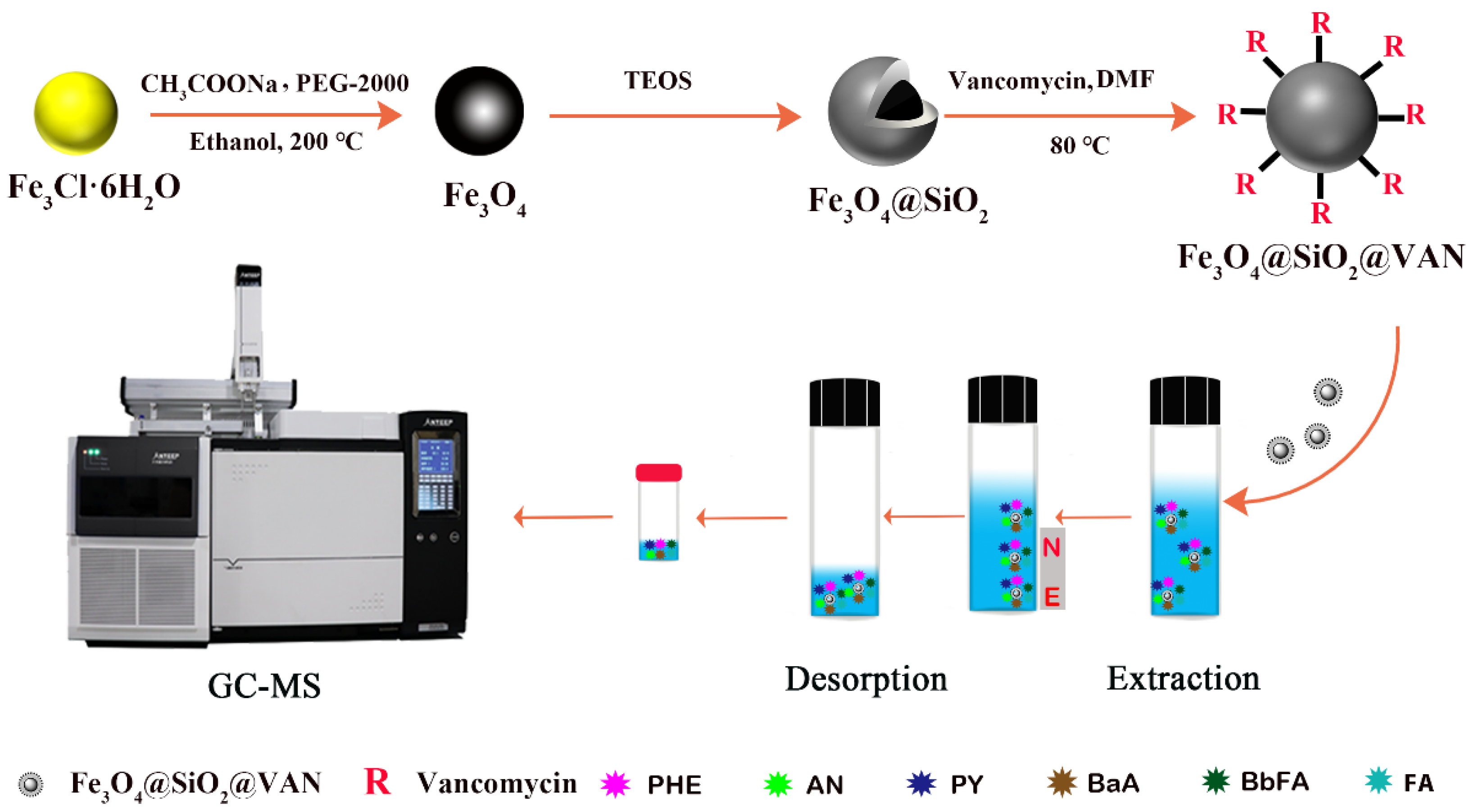
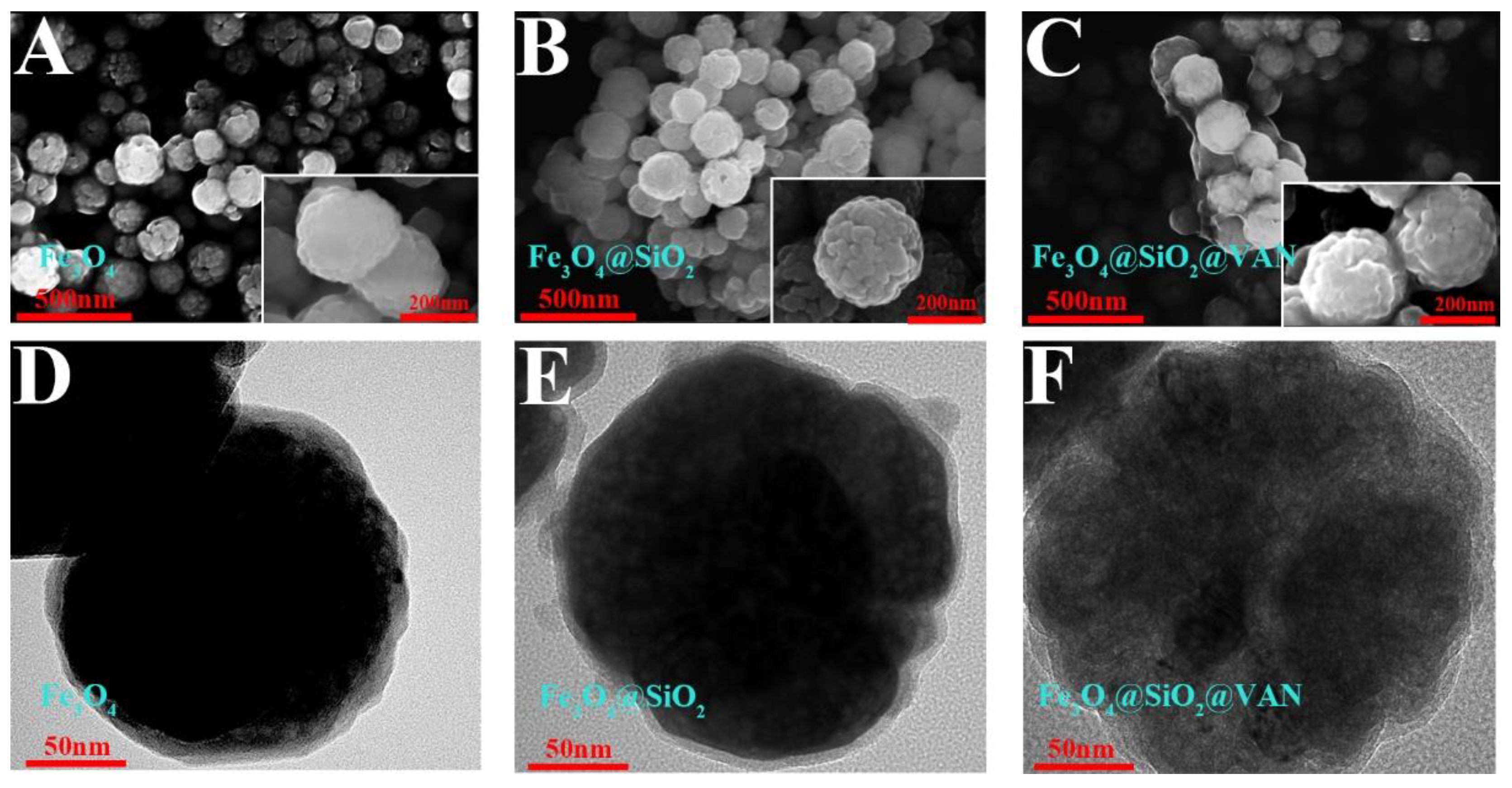
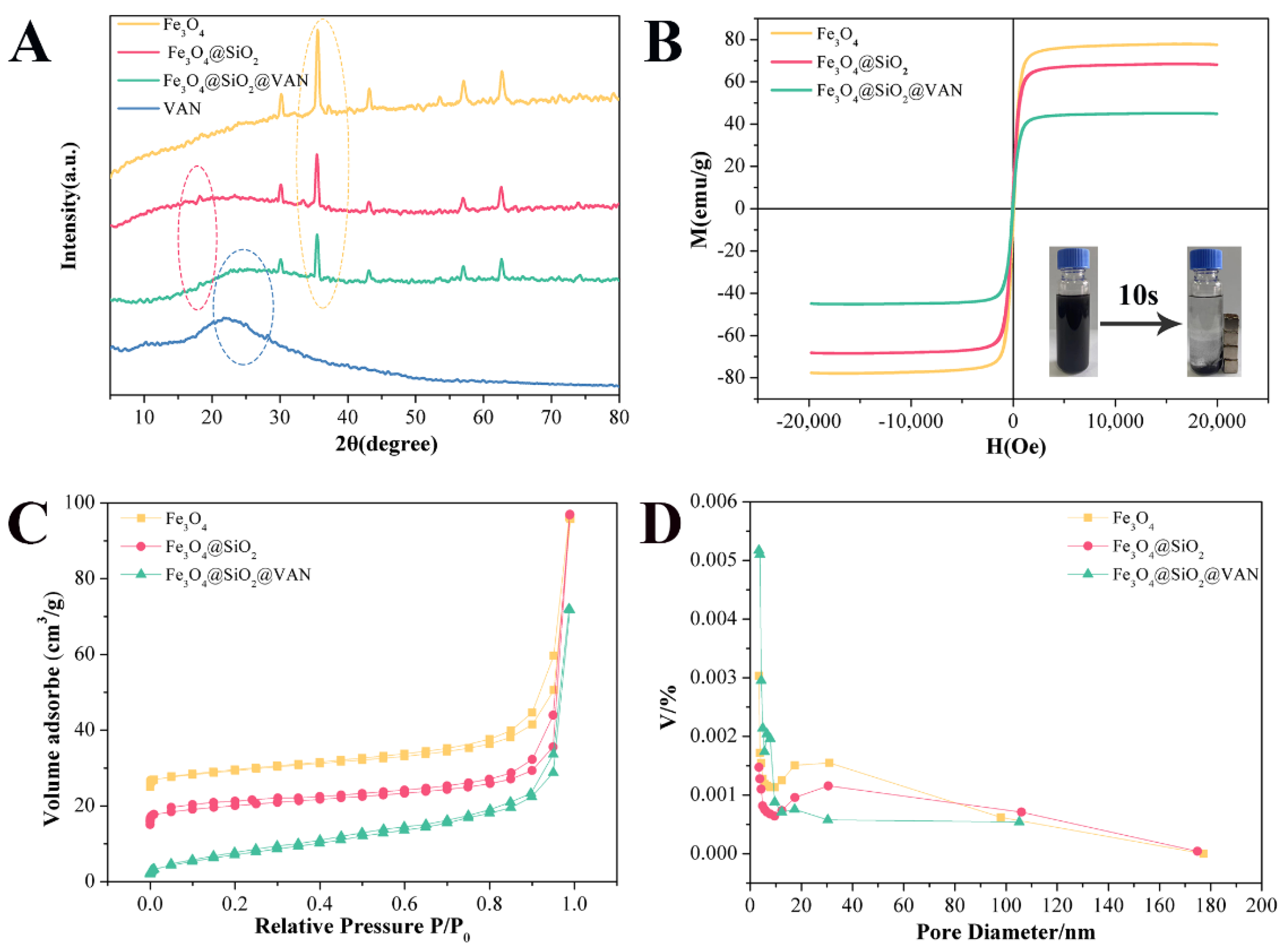
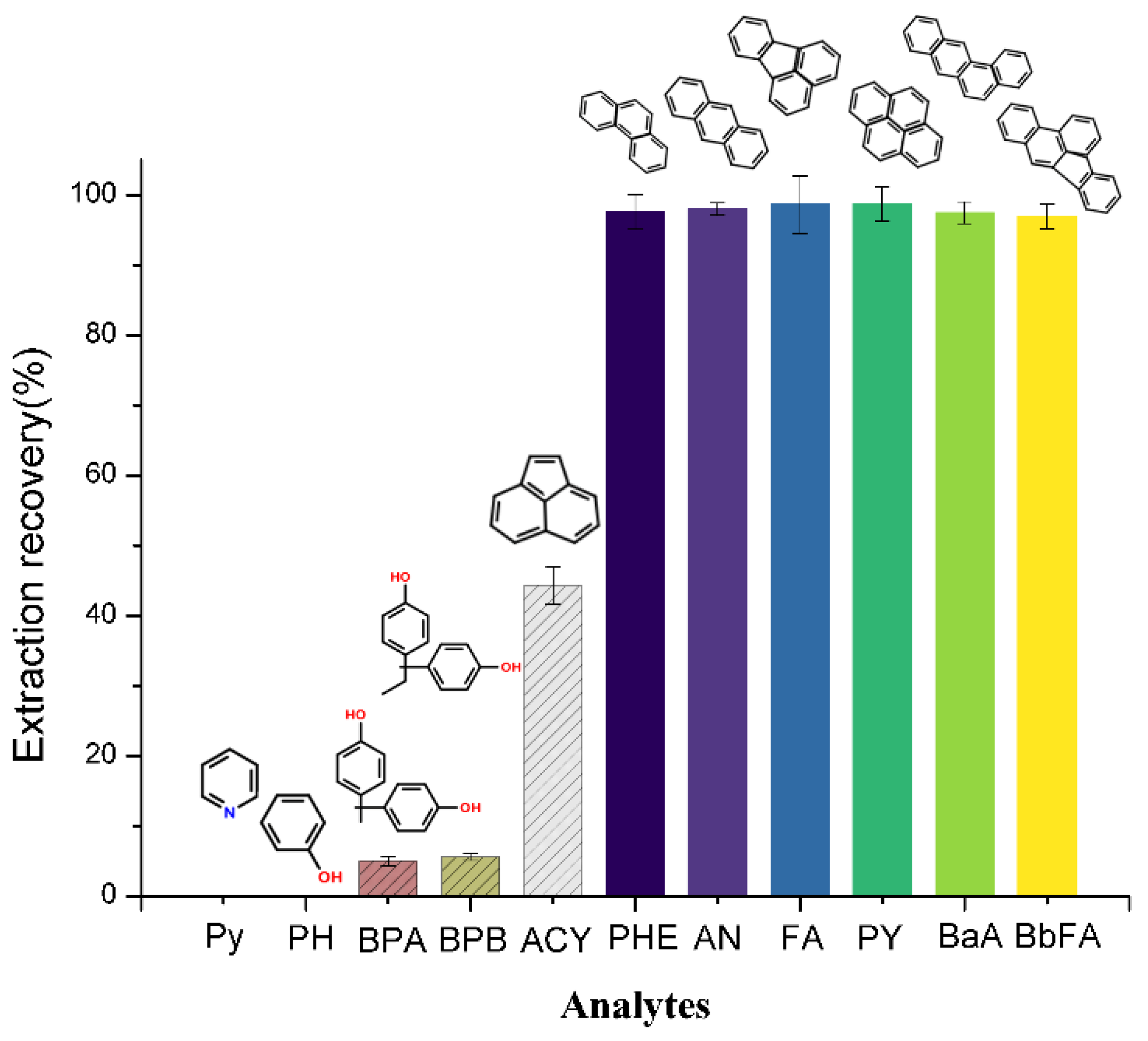
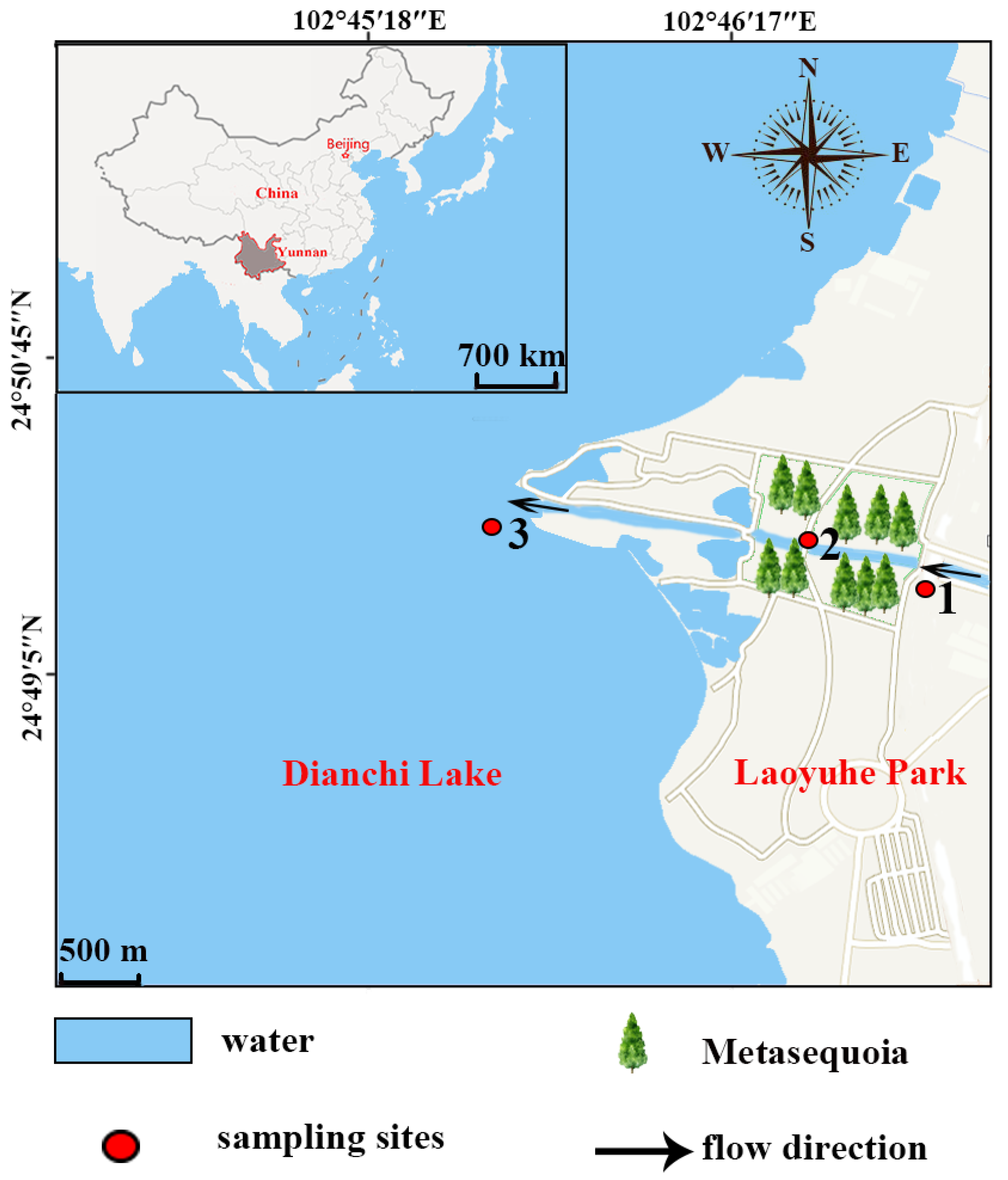
| Analyte | LODs (μg L−1) | LOQs (μg L−1) | Linear Range (μg L−1) | Linear Equation | Correlation Coefficient (R) |
|---|---|---|---|---|---|
| phenanthrene | 0.03 | 0.09 | 0.1–200 | Y = 862X-701 | 0.9923 |
| anthracene | 0.03 | 0.09 | 0.1–200 | Y = 1302X-1121 | 0.9863 |
| fluoranthene | 0.03 | 0.09 | 0.1–200 | Y = 1612X-1190 | 0.9997 |
| pyrene | 0.03 | 0.09 | 0.1–200 | Y = 4707X-2273 | 0.9906 |
| benzo[a]fluoranthene | 0.03 | 0.09 | 0.1–200 | Y = 1956X-1525 | 0.9945 |
| benzo[b]fluoranthene | 0.16 | 0.48 | 0.5–200 | Y = 1883X-1431 | 0.9963 |
| Sites | Analyte | Found (μg L−1) | Spiked Samples Analysis | |||||
|---|---|---|---|---|---|---|---|---|
| 1 μg L−1 | 50 μg L−1 | 100 μg L−1 | ||||||
| Recovery (%) | RSD (%) | Recovery (%) | RSD (%) | Recovery (%) | RSD (%) | |||
| Site 1 | phenanthrene | / | 95.70 | 1.13 | 116.32 | 1.21 | 96.96 | 2.73 |
| anthracene | / | 92.31 | 2.60 | 112.00 | 1.55 | 106.07 | 0.89 | |
| fluoranthene | / | 99.60 | 11.90 | 110.80 | 2.07 | 91.30 | 2.31 | |
| pyrene | 0.35 | 95.63 | 8.25 | 95.68 | 4.32 | 99.56 | 4.36 | |
| Benzo[a]anthracene | / | 97.64 | 5.26 | 119.00 | 3.71 | 98.23 | 3.85 | |
| Benzo[b]fluoranthene | / | 101.91 | 6.23 | 101.10 | 5.67 | 88.22 | 0.50 | |
| Site 2 | phenanthrene | / | 95.00 | 1.94 | 98.76 | 2.60 | 96.82 | 6.41 |
| anthracene | / | 85.63 | 12.82 | 89.00 | 5.04 | 105.11 | 3.94 | |
| fluoranthene | / | 100.00 | 2.02 | 86.62 | 4.15 | 103.47 | 4.78 | |
| pyrene | 0.26 | 98.18 | 2.80 | 85.40 | 6.31 | 107.00 | 10.22 | |
| Benzo[a]anthracene | / | 111.40 | 6.59 | 82.48 | 11.14 | 102.12 | 3.36 | |
| Benzo[b]fluoranthene | / | 87.32 | 8.08 | 91.87 | 11.72 | 102.47 | 2.79 | |
| Site 3 | phenanthrene | / | 82.49 | 3.06 | 97.00 | 4.24 | 102.00 | 2.56 |
| anthracene | / | 74.52 | 0.14 | 93.36 | 4.20 | 102.38 | 3.05 | |
| fluoranthene | / | 77.53 | 4.26 | 101.26 | 3.57 | 99.73 | 5.74 | |
| pyrene | 0.14 | 100.00 | 3.69 | 103.56 | 2.30 | 101.94 | 3.16 | |
| Benzo[a]anthracene | / | 85.63 | 9.08 | 94.04 | 1.01 | 101.49 | 0.52 | |
| Benzo[b]fluoranthene | / | 99.32 | 8.42 | 93.29 | 2.91 | 99.30 | 6.51 | |
| Sample | Sample Preparation | Sorbent | Adsorption Amount (mg) | Extraction Time (min) | Limit of Detection (μg L−1) | Detection Methods | References |
|---|---|---|---|---|---|---|---|
| water | MSPE | OPA/MMNPs | 50 | 1 (vortexed) | 0.016–0.07 | GC-MS | [32] |
| water | MSPE | Magnetic MIL-100(Fe) | 10 | 10 (ultrasounds) | 0.032–2.11 | HPLC-FLD | [33] |
| water | MSPE | g-C3N4/Fe3O4 | 10 | 10 (ultrasounds) | 0.05–0.10 | HPLC-FLD | [34] |
| water | MSPE | Fe3O4/GO | 40 | 10 (shaking) | 0.09–0.19 | HPLC-UV | [35] |
| water | MSPE | Fe3O4@COF–COOH | 10 | 10 (ultrasounds) | 0.025–10.0 | HPLC-DAD | [36] |
| water | MSPE | Carbon-ferromagnetic nanocomposite | 10 | 30 (shaking) | 0.015–0.335 | GC-MS | [37] |
| seawater | MSPE | PI@SiO2@Fe3O4 | 50 | 20 (stirring) | 0.15–0.19 | GC-FID | [38] |
| tap, river, well and reservoir waters | MSPE | Fe3O4@SiO2@MIM-PF6 | 30 | 7 (ultrasounds and stirring) | 0.04–1.11 | GC-MS | [39] |
| tap water | MSPE | Magnetic C18 microspheres | 50 | 1 (ultrasounds) | 0.8–36 | GC-MS | [40] |
| water | MSPE | Fe3O4@SiO2@VAN | 50 | 30 (stirring) | 0.03–0.16 | GC-MS | This work |
Publisher’s Note: MDPI stays neutral with regard to jurisdictional claims in published maps and institutional affiliations. |
© 2022 by the authors. Licensee MDPI, Basel, Switzerland. This article is an open access article distributed under the terms and conditions of the Creative Commons Attribution (CC BY) license (https://creativecommons.org/licenses/by/4.0/).
Share and Cite
Tian, Y.; Xu, Z.; Liu, Z.; Si, X.; Zhang, F.; Jiang, W. Fe3O4@SiO2@VAN Nanoadsorbent Followed by GC-MS for the Determination of Polycyclic Aromatic Hydrocarbons at Ultra-Trace Levels in Environmental Water Samples. Nanomaterials 2022, 12, 2921. https://doi.org/10.3390/nano12172921
Tian Y, Xu Z, Liu Z, Si X, Zhang F, Jiang W. Fe3O4@SiO2@VAN Nanoadsorbent Followed by GC-MS for the Determination of Polycyclic Aromatic Hydrocarbons at Ultra-Trace Levels in Environmental Water Samples. Nanomaterials. 2022; 12(17):2921. https://doi.org/10.3390/nano12172921
Chicago/Turabian StyleTian, Yu, Zhigang Xu, Zhimin Liu, Xiaoxi Si, Fengmei Zhang, and Wei Jiang. 2022. "Fe3O4@SiO2@VAN Nanoadsorbent Followed by GC-MS for the Determination of Polycyclic Aromatic Hydrocarbons at Ultra-Trace Levels in Environmental Water Samples" Nanomaterials 12, no. 17: 2921. https://doi.org/10.3390/nano12172921
APA StyleTian, Y., Xu, Z., Liu, Z., Si, X., Zhang, F., & Jiang, W. (2022). Fe3O4@SiO2@VAN Nanoadsorbent Followed by GC-MS for the Determination of Polycyclic Aromatic Hydrocarbons at Ultra-Trace Levels in Environmental Water Samples. Nanomaterials, 12(17), 2921. https://doi.org/10.3390/nano12172921





